Transportation Management System Market Size and Share
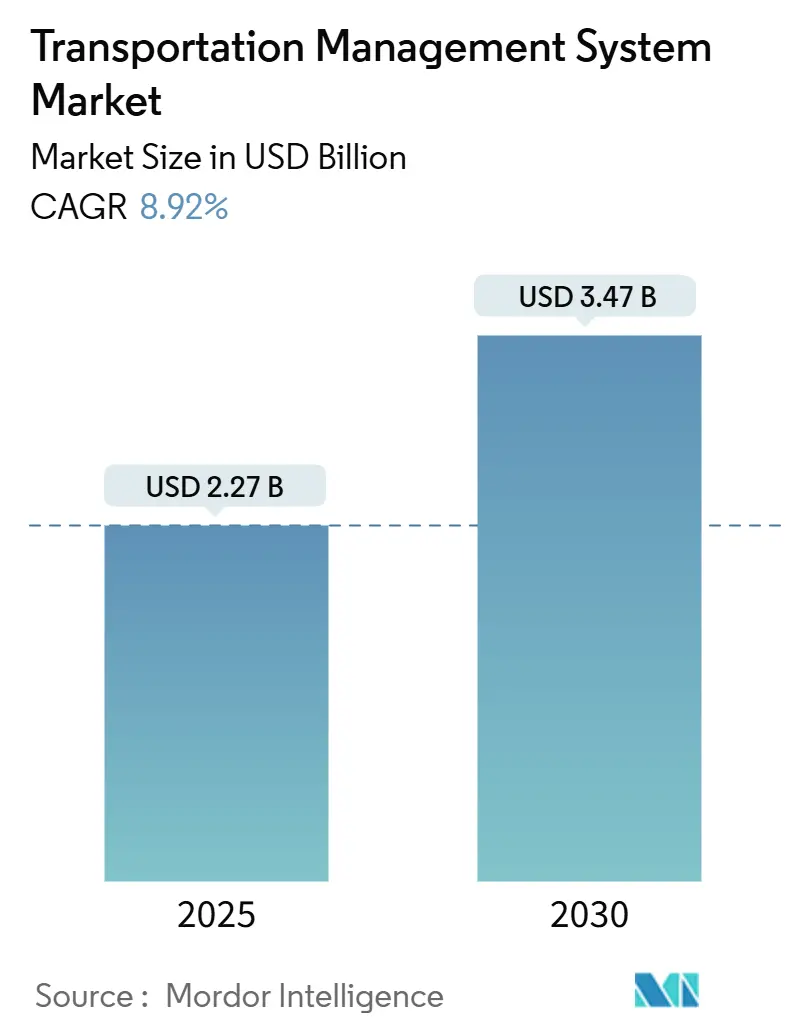
Transportation Management System Market Analysis by Mordor Intelligence
The Transportation Management System Market size is estimated at USD 2.27 billion in 2025, and is expected to reach USD 3.47 billion by 2030, at a CAGR of 8.92% during the forecast period (2025-2030).
The acceleration stems from enterprises replacing capital-heavy on-premises tools with scalable cloud platforms that deliver rapid deployment, lower total cost of ownership, and real-time operational visibility. Regulatory mandates for electronic logging devices (ELDs) and greenhouse-gas reporting are turning compliance data into strategic intelligence, while e-commerce growth amplifies demand for sophisticated last-mile and multimodal optimisation. Freight-marketplace integrations now let shippers secure spot capacity on the fly, and AI-driven ETA engines reduce detention penalties, lifting supply-chain service levels even as sustainability targets tighten.
Key Report Takeaways
- By deployment, cloud held 63% transportation management system market share in 2024 and is advancing at 14.92% CAGR through 2030.
- By enterprise size, large enterprises accounted for 62% of the transportation management system market in 2024, but SMEs are expanding at a 15% CAGR to 2030.
- By mode of transportation, roadways dominated with 58% revenue in 2024, whereas the airways segment is projected to grow at 12.8% CAGR to 2030.
- By region, North America led with 38% of the transportation management system market size in 2024; Asia-Pacific is poised to post 13.9% CAGR through 2030.
Global Transportation Management System Market Trends and Insights
Drivers Impact Analysis
| Driver | (~) % Impact on CAGR Forecast | Geographic Relevance | Impact Timeline |
|---|---|---|---|
| Cloud-based TMS adoption accelerates cost-to-serve savings | +2.1% | Global, with early gains in North America & EU | Medium term (2-4 years) |
| E-commerce & omnichannel retail demand real-time, last-mile optimisation | +1.8% | Global, concentrated in urban centers | Short term (≤ 2 years) |
| Regulatory push for ELD & Green-house-gas reporting digitalises freight | +1.4% | North America & EU core, spill-over to APAC | Long term (≥ 4 years) |
| Freight-marketplace convergence enables dynamic capacity procurement | +1.2% | North America, expanding to Europe & APAC | Medium term (2-4 years) |
| AI-driven predictive ETA tools cut detention/SLA penalties | +1.0% | Global, with advanced adoption in developed markets | Short term (≤ 2 years) |
| API-first micro-services unlock modular TMS for SMEs | +0.7% | Global, particularly beneficial for emerging markets | Medium term (2-4 years) |
| Source: Mordor Intelligence | |||
Cloud-based TMS adoption accelerates cost-to-serve savings
Cloud deployments cut hardware and IT overhead, trimming total cost of ownership by 30% compared with legacy systems. They synchronise shipment data across facilities in real time, yielding centralised visibility and rapid exception management. Microservices architecture lets shippers activate modules incrementally, avoiding the risk of big-bang rollouts. Vendors offer subscription pricing that aligns technology costs with freight volumes, while embedded AI suggests lower-carbon routes that align with sustainability targets. These factors position cloud as the default architecture for new transportation management system market implementations. [1]Generix Group, “Why You Should Migrate Your WMS to the Cloud,”generixgroup.com
E-commerce & omnichannel retail demand real-time last-mile optimization
Same-day and next-day delivery expectations have moved route planning from static to dynamic. Modern TMS engines ingest traffic, weather, and carrier capacity data every few minutes, rerouting drivers and automating customer alerts. Last-mile costs can reach 53% of total shipping spend, and AI-enabled optimisation is cutting that burden for retailers that pivot to unified order orchestration platforms. Advanced geofencing supports curb side pickup and store-to-door fulfilment, while predictive ETAs boost first-attempt delivery success, raising NPS scores and revenue retention.
Regulatory push for ELD & greenhouse-gas reporting digitalizes freight
Rules such as California’s Clean Truck Check are forcing fleets to capture and share granular emissions data, with projected NOx reductions exceeding 81 tons per day by 2037. Mandatory ELD telematics feed TMS dashboards, automating Hours-of-Service checks and flagging non-compliant drivers before fines accrue. Shippers are also benchmarking carriers on carbon per shipment, and many tender algorithms now weigh emissions alongside rate and service. Regulatory compliance therefore doubles as a catalyst for wider digital transformation across the transportation management system market. [2]Trimble, “Preparing for CARB's Clean Truck Check Regulations,” transportation.trimble.com
Freight-marketplace convergence enables dynamic capacity procurement
Digital freight-matching APIs pipe live spot rates into TMS tendering screens, letting users auto-award loads to best-fit carriers based on cost, on-time metrics, and sustainability performance. Machine-learning models score carrier reliability and predict empty-mile risk, trimming dead-head journeys. As platform interoperability improves, shippers push more of their freight spend through marketplace-connected TMS workflows, driving real-time procurement efficiencies and elevating service resilience in volatile capacity cycles.
Restraints Impact Analysis
| Restraint | (~) % Impact on CAGR Forecast | Geographic Relevance | Impact Timeline |
|---|---|---|---|
| High integration cost with legacy ERP/WMS stacks | -1.5% | Global, particularly acute in manufacturing sectors | Medium term (2-4 years) |
| Data-security & privacy concerns for cloud deployments | -0.8% | EU & regulated industries globally | Short term (≤ 2 years) |
| Shortage of in-house data-science talent to exploit analytics modules | -0.6% | Global, more pronounced in emerging markets | Long term (≥ 4 years) |
| Fragmented carrier-telematics standards hinder multimodal visibility | -0.4% | Global, with regional variations in standards adoption | Long term (≥ 4 years) |
| Source: Mordor Intelligence | |||
High integration cost with legacy ERP/WMS stacks
Enterprises often run heavily customised ERP and WMS platforms that lack modern APIs, pushing TMS integration projects to 6-18 months and budgets from USD 500,000 to USD 5 million. Data migration uncovers inconsistent formats and outdated business logic, requiring extensive cleansing. Parallel system runs prolong go-live cycles, and middleware layers add licence fees. These hurdles delay ROI and deter some organisations from upgrading, especially in capital-intensive manufacturing where downtime risks are high.
Data-security & privacy concerns for cloud deployments
Transportation data exposes shipment values, customer locations, and trade lanes. GDPR and sector-specific rules impose strict controls, leading some EU shippers to favour private clouds or hybrid models. Multi-tenant SaaS expands the attack surface, and few organisations possess in-house cybersecurity teams versed in logistics protocols. Concerns centre on cross-border data flows, vulnerability management, and breach notification obligations, all of which can slow cloud TMS adoption in regulated segments of the transportation management system industry.
Segment Analysis
By Mode of Transportation: Roadways dominate while airways accelerate
Road freight delivered 58% of transportation management system market revenue in 2024 thanks to its ubiquity in last-mile and regional haulage. TMS modules for truckload and less-than-truckload optimise lane pricing, back-haul filling, and detention avoidance. Intermodal connectors allow truck legs to synchronise with rail ramps, strengthening network agility. The airway segment, posting 12.8% CAGR, underscores the rise of e-commerce cross-border parcels and high-value cargo. AI-based load-planning cuts under-utilisation in belly space, and real-time milestone tracking mitigates dwell fees at major hubs. As predictive analytics refine slot booking at cargo terminals, shippers gain a premium-cost yet high-reliability option that balances inventory velocity with service promises.
The transportation management system market size attributed to road-based solutions is forecast to grow alongside regulatory pushes for lower emissions zones that require granular trip visibility. Conversely, air-cargo optimisation platforms integrate weather analytics and slot rescheduling features to contain service-disruption risk. While maritime and rail retain dedicated user bases for bulk moves, vendors are integrating container visibility data and train schedules to build true end-to-end orchestration inside a single TMS cockpit. These shifts ensure every mode contributes differentiated value as the transportation management system market widens its technological scope. [3]FleetOwner, “Advancing Fleet Intelligence,” fleetowner.com
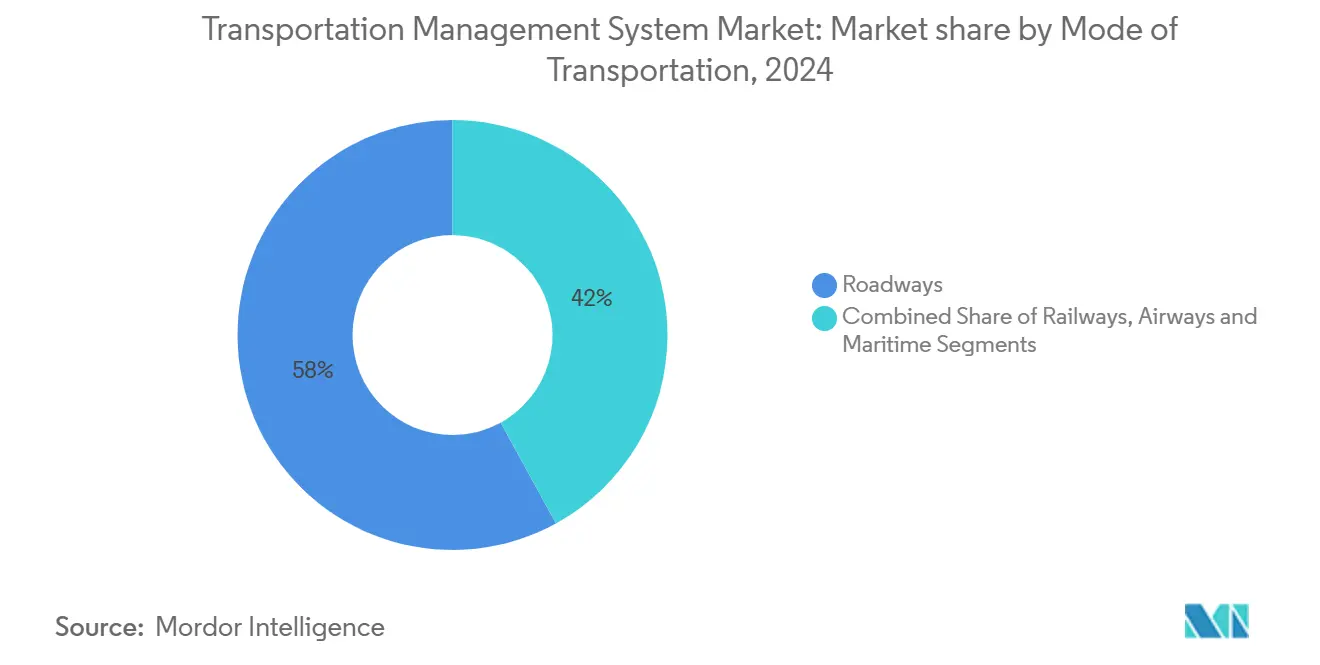
Note: Segment shares of all individual segments available upon report purchase
By Deployment: Cloud supremacy accelerates SME access
Cloud captured 63% transportation management system market share in 2024 and is on track for 14.92% CAGR on the back of rapid onboarding cycles that often conclude within eight weeks. Subscription pricing converts capex to opex, freeing budget for advanced modules such as predictive ETAs and automated freight audit. API-first design links easily with carrier portals, IoT beacons, and analytics engines, forming an extensible ecosystem that evolves with user needs. On-premise persists in sectors with strict data residency mandates, though hybrid footprints are bridging that gap by retaining sensitive data behind the firewall while pushing high-volume optimisation jobs to the cloud.
Cloud’s democratisation effect is most visible among smaller shippers. SMEs can now procure enterprise-grade optimisation without hardware spend or specialist IT teams, driving 15% CAGR in the segment. The transportation management system market size for SME-focused SaaS is expected to double between 2025 and 2030, reinforcing cloud’s status as the default deployment paradigm across regions.
By Enterprise Size: SME growth outpaces large-enterprise adoption
Large enterprises held 62% of 2024 revenue because their multi-plant, multi-mode networks demand sophisticated orchestration across ERP, WMS, and yard systems. They invest in AI accelerators to automate tendering, carbon accounting, and predictive maintenance. Yet the fastest momentum resides with SMEs, expanding at 15% CAGR as vendors release out-of-the-box workflows and freemium tiers that lower switching barriers. Such offerings compress implementation to weeks, and templated dashboards surface actionable KPIs without custom coding.
As the transportation management system market broadens, microenterprises discover mobile-native apps for dispatch and telematics, allowing owner-operators to claim spot loads and produce real-time proof-of-delivery. This diffusion of capability ensures digital logistics no longer remains an exclusive province of Fortune 500 manufacturers.
By End-user Industry: Manufacturing leads while retail accelerates
Discrete manufacturing anchors demand because production schedules rely on synchronised inbound flows. Automotive OEMs feed just-in-time lines with TMS signals that trigger parts release, carrier notification, and customs clearance in one workflow. Food and beverage shippers track cold-chain compliance and shelf-life status, with geofence alerts for temperature deviations. Retail and e-commerce, posting double-digit growth, need high-throughput parcel routing and last-mile visibility, fuelling additional transportation management system market adoption.
Healthcare adds stringent chain-of-custody documentation and refrigeration telemetry, prompting niche vendors to refine compliance templates. Third-party logistics providers, meanwhile, consume multi-tenant TMS instances to manage diverse client rules, proving that vertical specialisation drives product evolution in the transportation management system industry.
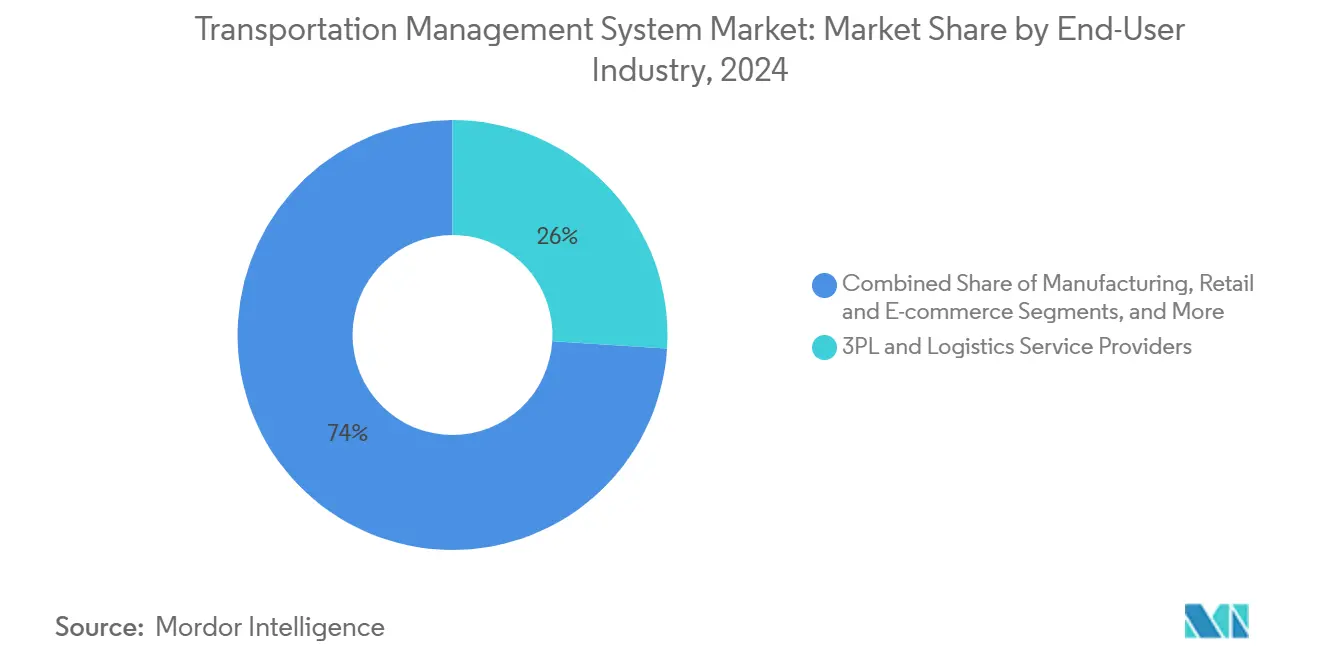
Note: Segment shares of all individual segments available upon report purchase
By Component: Software dominance with services growth
Core software represents the bulk of spending, encompassing load planning, carrier management, visibility, and analytics. However, services are rising quickly. Consulting helps shippers architect best-fit deployments, and integration specialists align TMS data flows with ERP, WMS, and order management. Managed optimisation services run continuous improvement loops that mine shipment history to refine rate negotiations and mode decisions. As AI models mature, vendors package data-science advisory to help users operationalise predictive recommendations.
The shift to subscription licensing underpins recurring revenue, allowing vendors to fund continuous R&D that infuses AI, IoT, and blockchain capabilities into baseline offerings. In turn, this accelerates upgrade cycles and cements the long-term growth path of the transportation management system market.
By Application: Route planning leads while real-time visibility accelerates
Route optimisation remains the largest use-case because it delivers direct fuel, labour, and asset-utilisation gains. Dynamic algorithms cut empty miles and slash detention fees while respecting service windows. Real-time visibility is the fastest climber as customers expect live tracking links and proactive delay alerts. Event-driven workflows trigger exception playbooks, such as auto-rebooking for missed cut-offs, improving resilience.
Freight audit and payment modules automate invoice validation, recovering duplicate charges and creating data lakes for spend analytics. Inventory integration ensures transit times align with safety-stock targets, preventing line-shutdowns and markdowns. Together these applications reinforce the holistic value of TMS beyond mere routing, propelling continued expansion of the transportation management system market.
Geography Analysis
North America generated 38% of transportation management system market revenue in 2024, underpinned by early adoption of cloud logistics suites and regulatory catalysts like ELD mandates. United States shippers leverage mature carrier networks and detailed rate-base data to refine optimisation scenarios. Canada’s cross-border trade with the US boosts demand for customs-ready workflows, while Mexico benefits from nearshoring trends that push manufacturers to digitise freight corridors quickly.
Asia-Pacific leads growth at 13.9% CAGR to 2030 as e-commerce volumes soar across China, India, and Southeast Asia. Chinese parcel networks rely on AI route sequencers that compress urban lead times to under two hours. Indian manufacturers adopt TMS to orchestrate multimodal moves across fragmented infrastructure, balancing cost and service. Japan’s Society 5.0 blueprint spurs investments in IoT-rich logistics that integrate factory sensors with carrier networks, further enlarging the transportation management system market. [4]EU-Japan Center for Industrial Cooperation, “Digital Transformation in Japan,” eu-japan.eu
Europe commands a notable share owing to stringent sustainability directives and complex cross-border trade rules. German exporters integrate CO₂ calculators into tendering engines, French retailers deploy multimodal TMS to cut congestion charges, and UK shippers post-Brexit need advanced customs screening. Middle East and Africa witness incremental uptake aligned with port expansions and free-trade zones, whereas South America’s growing e-commerce and infrastructure modernisation open fresh lanes for transportation management system market penetration.
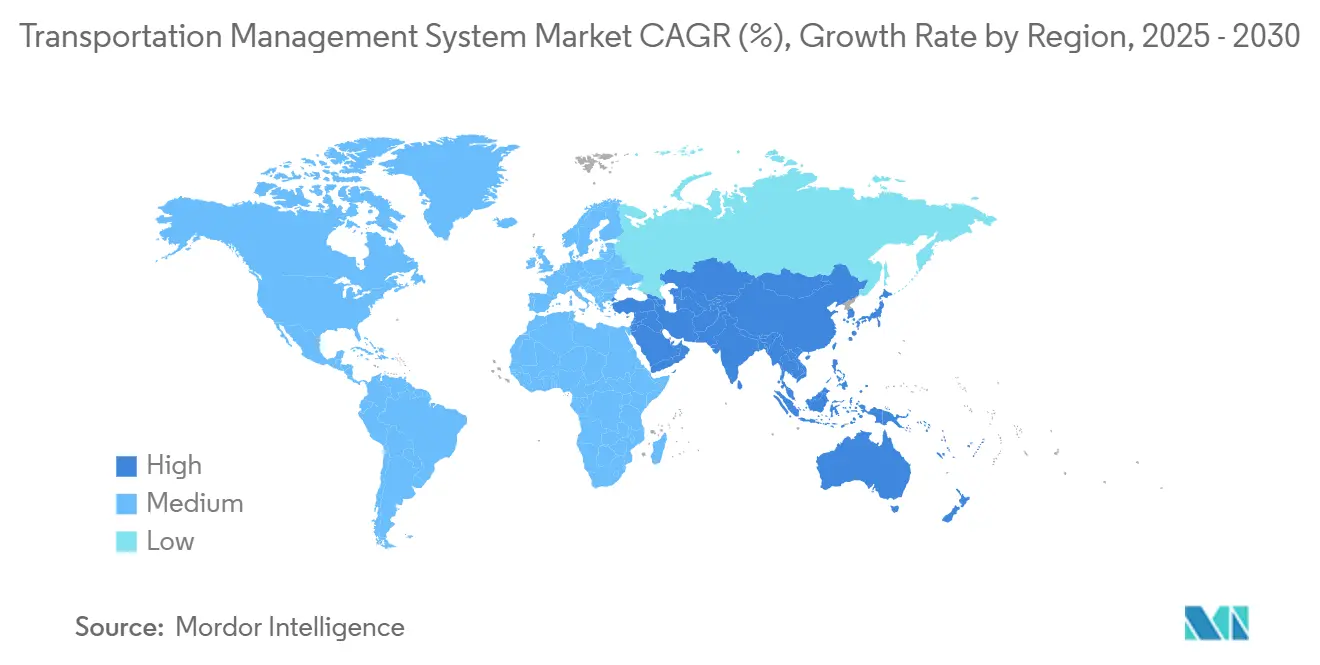
Competitive Landscape
The transportation management system market features moderate fragmentation. Megavendors such as SAP, Oracle, and Trimble offer end-to-end suites spanning planning, execution, and analytics, reinforced by global SI partnerships. Specialist providers like MercuryGate and Blue Yonder differentiate through deep mode algorithms and rapid cloud rollouts. AI-native entrants deploy agent-based architectures that automate tendering and exception resolution, challenging incumbents on speed and autonomy.
M&A activity remains brisk. Vendors acquire telematics firms to fold sensor data into predictive ETA engines, or snap up freight-marketplace start-ups for real-time rate feeds. Platform consolidation is driven by shipper demand for single-pane control covering order, warehouse, and transport flows. Radiant Logistics notes that ROI proof points, such as USD 5 million in annual savings at Modern Transportation, are critical for vendor shortlists.
Pricing competition is shifting from licence fees to value-based models where cost recovery ties to documented savings. Vendors capable of quantifying carbon reductions in parallel with freight savings gain strategic advantage. As a result, the transportation management system market rewards providers that demonstrate provable efficiency and sustainability metrics alongside seamless integration.
Transportation Management System Industry Leaders
-
SAP SE
-
Oracle Corporation
-
Blue Yonder (JDA)
-
Descartes Systems Group
-
Manhattan Associates
- *Disclaimer: Major Players sorted in no particular order
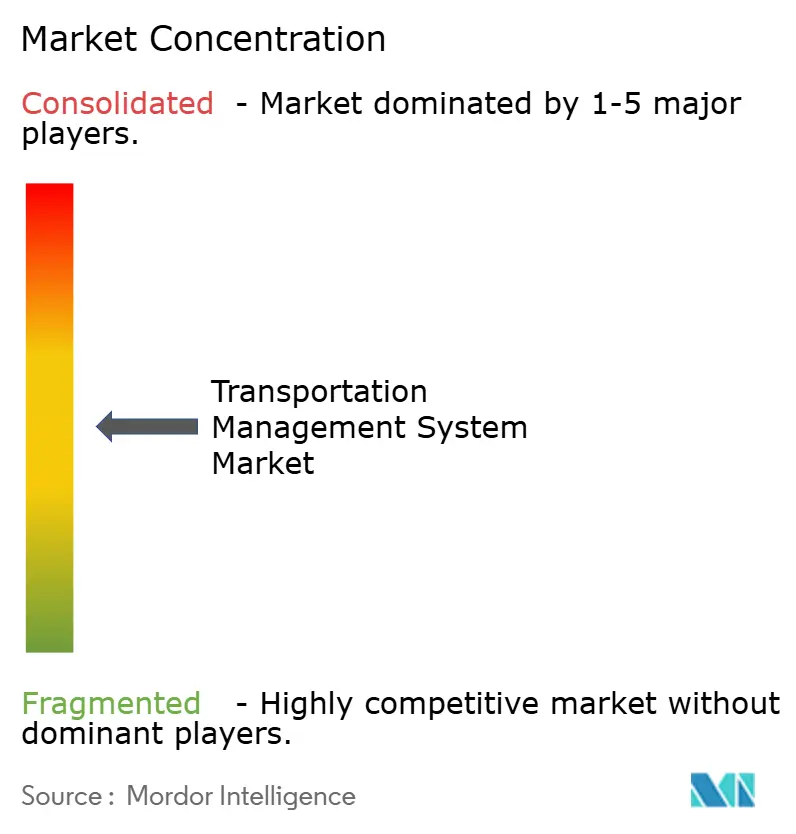
Recent Industry Developments
- June 2025: Modern Transportation realised USD 5 million annual savings after adopting BeyondTrucks multi-tenant TMS.
- May 2025: Uber Freight launched an AI logistics network comprising 30 autonomous agents, processing USD 1.6 billion in freight for clients including Colgate-Palmolive.
- April 2025: AROBS Transilvania Software posted RON 415 million turnover for 2024 and acquired SVT Electronics to deepen logistics technology capabilities.
- March 2025: Omniful enhanced cloud TMS for e-commerce fulfilment with expanded fleet-management and live-tracking features.
Research Methodology Framework and Report Scope
Market Definitions and Key Coverage
Our study defines the transportation management system (TMS) market as cloud-based and on-premises software that helps shippers, carriers, and logistics partners plan, execute, and optimize the physical movement of goods while providing visibility, payment, and audit functions. We, the Mordor Intelligence team, measure revenues that flow from license, subscription, and managed-platform fees generated by vendors that own and maintain the core TMS codebase.
Scope exclusion: Fleet telematics hardware, pure freight-brokerage revenue, and standalone route-planning apps fall outside this scope.
Segmentation Overview
- By Mode of Transportation
- Roadways
- Railways
- Airways
- Maritime
- By Deployment
- On-premise
- Cloud
- Hybrid
- By Enterprise Size
- Large Enterprises
- Small & Medium Enterprises
- Micro Enterprises
- By End-user Industry
- Manufacturing
- Retail and E-commerce
- Food and Beverage
- Healthcare and Pharmaceuticals
- Automotive
- 3PL and Logistics Service Providers
- By Component
- Software
- Services
- Consulting
- Integration and Implementation
- Support and Maintenance
- By Application
- Order Management
- Route Planning and Optimization
- Freight Audit and Payment
- Real-time Visibility and Tracking
- Inventory and Warehouse Integration
- By Geography
- North America
- United States
- Canada
- Mexico
- Europe
- United Kingdom
- Germany
- France
- Italy
- Rest of Europe
- Asia-Pacific
- China
- Japan
- India
- South Korea
- Rest of Asia-Pacific
- Middle East and Africa
- Middle East
- Israel
- Saudi Arabia
- United Arab Emirates
- Turkey
- Rest of Middle East
- Africa
- South Africa
- Egypt
- Rest of Africa
- Middle East
- South America
- Brazil
- Argentina
- Rest of South America
- North America
Detailed Research Methodology and Data Validation
Primary Research
We interviewed software product managers, third-party logistics users, and independent freight auditors across North America, Europe, and fast-growing Asia Pacific. Their insights clarified typical seat counts, integration pain points, and the pace at which legacy on-premise systems are being switched to multi-tenant SaaS, allowing us to tighten penetration curves and future growth limits.
Desk Research
Mordor analysts began with public macro sources such as the World Bank logistics indicators, UN Comtrade shipment flows, and national transport statistics bureaus to size freight volumes that ultimately drive TMS adoption. Trade association white papers from bodies such as the Council of Supply Chain Management Professionals and the American Trucking Associations provided cost benchmarks and digitization ratios, while patent analytics from Questel and targeted news retrieval through Dow Jones Factiva highlighted innovation hotspots and vendor activity. Company 10-Ks, investor decks, and SEC filings then helped us anchor average selling prices and deployment mix. This list is illustrative, not exhaustive; many additional secondary inputs were reviewed to refine assumptions and cross-check figures.
Market-Sizing & Forecasting
A top-down "freight-spend pool x digitization rate" model establishes the 2024 baseline, which is then corroborated with selective bottom-up checks such as sampled vendor revenue roll-ups and regional channel feedback. Key variables include global freight expenditure, cross-border e-commerce volume, average subscription price per shipment, SaaS migration share, regulatory e-logging mandates, and supply-chain resilience investments, all forecast through 2030.
For projections, multivariate regression combining freight-spend growth with SaaS penetration and price-elasticity factors produced a base CAGR that our primary experts validated. Where bottom-up revenue tallies diverged, gaps were reconciled by adjusting regional take-up rates instead of altering total spend pools.
Data Validation & Update Cycle
Model outputs pass variance checks against historical vendor disclosures; anomalies trigger senior analyst reviews before sign-off. The dataset refreshes annually, with interim updates whenever material events, such as major M&A, regulatory shifts, or macro shocks, alter market dynamics.
Why Mordor's Transportation Management System Baseline Commands Confidence
Published estimates seldom align because firms choose different revenue buckets, discounting rules, and refresh cadences. According to our analysis, the largest gaps arise when other publishers bundle brokerage margin, include telematics devices, or extrapolate aged adoption ratios without verifying recent SaaS pricing trends.
Benchmark comparison
| Market Size | Anonymized source | Primary gap driver |
|---|---|---|
| USD 12.94 B (2024) | Mordor Intelligence | - |
| USD 13.50 B (2023) | Global Consultancy A | Includes brokerage and visibility-only tools; older price deck used |
| USD 10.45 B (2023) | Trade Journal B | Excludes mid-market SaaS vendors; limited Asia Pacific sampling |
These comparisons show that Mordor's disciplined scope, dual-layer modeling, and annual refresh give decision-makers a balanced, transparent baseline that is traceable to clear variables and repeatable steps.
Key Questions Answered in the Report
What is the current size of the transportation management system market?
The transportation management system market size stands at USD 2.27 billion in 2025 and is forecast to reach USD 3.47 billion by 2030.
Which deployment model is growing fastest in transportation management systems?
Cloud deployment leads with 63% revenue in 2024 and is expanding at 14.92% CAGR because it cuts capital costs and speeds implementation.
Why are SMEs adopting TMS platforms rapidly?
SMEs gain access to modular, subscription-priced solutions that lower IT overhead and can reduce logistics costs by up to 30%, driving 15% CAGR uptake.
How are regulations influencing TMS adoption?
ELD and greenhouse-gas rules require detailed data capture, prompting fleets to integrate telematics with TMS dashboards for automated compliance and optimisation.
Which region will see the highest TMS market growth through 2030?
Asia-Pacific is projected to record a 13.9% CAGR as e-commerce and manufacturing digitalisation programs accelerate platform deployment.
What technological trend will shape future TMS capabilities?
AI-powered freight-marketplace convergence will enable real-time capacity procurement and predictive analytics for continuous cost and service improvement.
Page last updated on:



